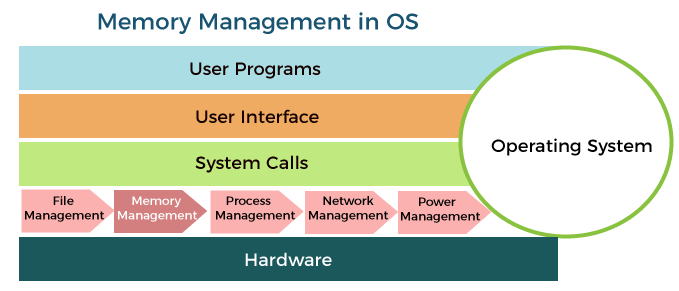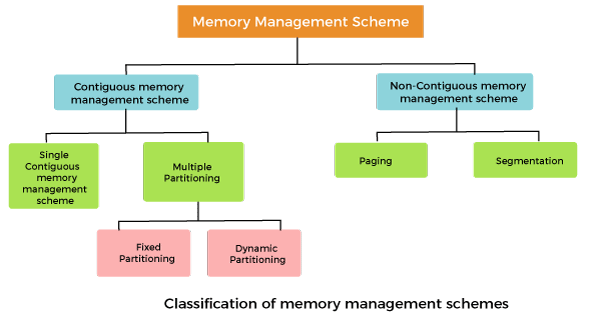Memory Management in Operating System (OS)In this article, we will understand memory management in detail. What do you mean by memory management? Memory is the important part of the computer that is used to store the data. Its management is critical to the computer system because the amount of main memory available in a computer system is very limited. At any time, many processes are competing for it. Moreover, to increase performance, several processes are executed simultaneously. For this, we must keep several processes in the main memory, so it is even more important to manage them effectively. 
Role of Memory managementFollowing are the important roles of memory management in a computer system:
Memory Management Techniques:The memory management techniques can be classified into following main categories:

Contiguous memory management schemes:In a Contiguous memory management scheme, each program occupies a single contiguous block of storage locations, i.e., a set of memory locations with consecutive addresses. Single contiguous memory management schemes:The Single contiguous memory management scheme is the simplest memory management scheme used in the earliest generation of computer systems. In this scheme, the main memory is divided into two contiguous areas or partitions. The operating systems reside permanently in one partition, generally at the lower memory, and the user process is loaded into the other partition. Advantages of Single contiguous memory management schemes:
Disadvantages of Single contiguous memory management schemes:
Multiple Partitioning:The single Contiguous memory management scheme is inefficient as it limits computers to execute only one program at a time resulting in wastage in memory space and CPU time. The problem of inefficient CPU use can be overcome using multiprogramming that allows more than one program to run concurrently. To switch between two processes, the operating systems need to load both processes into the main memory. The operating system needs to divide the available main memory into multiple parts to load multiple processes into the main memory. Thus multiple processes can reside in the main memory simultaneously. The multiple partitioning schemes can be of two types:
Fixed PartitioningThe main memory is divided into several fixed-sized partitions in a fixed partition memory management scheme or static partitioning. These partitions can be of the same size or different sizes. Each partition can hold a single process. The number of partitions determines the degree of multiprogramming, i.e., the maximum number of processes in memory. These partitions are made at the time of system generation and remain fixed after that. Advantages of Fixed Partitioning memory management schemes:
Disadvantages of Fixed Partitioning memory management schemes:
Dynamic PartitioningThe dynamic partitioning was designed to overcome the problems of a fixed partitioning scheme. In a dynamic partitioning scheme, each process occupies only as much memory as they require when loaded for processing. Requested processes are allocated memory until the entire physical memory is exhausted or the remaining space is insufficient to hold the requesting process. In this scheme the partitions used are of variable size, and the number of partitions is not defined at the system generation time. Advantages of Dynamic Partitioning memory management schemes:
Disadvantages of Dynamic Partitioning memory management schemes:
Non-Contiguous memory management schemes:In a Non-Contiguous memory management scheme, the program is divided into different blocks and loaded at different portions of the memory that need not necessarily be adjacent to one another. This scheme can be classified depending upon the size of blocks and whether the blocks reside in the main memory or not. What is paging?Paging is a technique that eliminates the requirements of contiguous allocation of main memory. In this, the main memory is divided into fixed-size blocks of physical memory called frames. The size of a frame should be kept the same as that of a page to maximize the main memory and avoid external fragmentation. Advantages of paging:
What is Segmentation?Segmentation is a technique that eliminates the requirements of contiguous allocation of main memory. In this, the main memory is divided into variable-size blocks of physical memory called segments. It is based on the way the programmer follows to structure their programs. With segmented memory allocation, each job is divided into several segments of different sizes, one for each module. Functions, subroutines, stack, array, etc., are examples of such modules.
Next TopicMonolithic Structure of Operating System
|
 For Videos Join Our Youtube Channel: Join Now
For Videos Join Our Youtube Channel: Join Now
Feedback
- Send your Feedback to [email protected]
Help Others, Please Share









